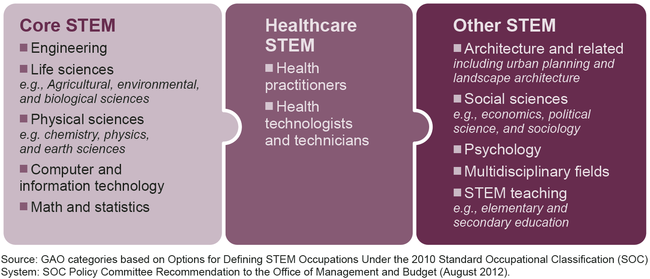Science, Technology, Engineering, and Mathematics Education: Assessing the Relationship between Education and the Workforce
Highlights
What GAO Found
Both the number of science, technology, engineering, and mathematics (STEM) degrees awarded and the number of jobs in STEM fields increased in recent years. The number of degrees awarded in STEM fields grew 55 percent from 1.35 million in the 2002-2003 academic year to over 2 million in the 2011-2012 academic year, while degrees awarded in non-STEM fields increased 37 percent. Since 2004, the number of STEM jobs increased 16 percent from 14.2 million to 16.5 million jobs in 2012, and non-STEM jobs remained fairly steady. The trends in STEM degrees and jobs varied across STEM fields. It is difficult to know if the numbers of STEM graduates are aligned with workforce needs, in part because demand for STEM workers fluctuates. For example, the number of jobs in core STEM fields, including engineering and information technology, declined during the recession but has grown substantially since then.
Science, Technology, Engineering, and Mathematics (STEM) Fields

Almost all of the 124 federal postsecondary STEM education programs that responded to GAO's survey reported that they considered workforce needs in some way. For example, the most common program objective was to prepare students for STEM careers. Some of these programs focused on occupations they considered to be in demand and/or related to their agency's mission. Many postsecondary programs also aimed to increase the diversity of the STEM workforce or prepare students for innovation. Most STEM programs reported having some outcome measures in place, but GAO found that some programs did not measure an outcome directly related to their stated objectives. As GAO recommended in 2012, the National Science and Technology Council recently issued guidance to help agencies better incorporate STEM education outcomes into their performance plans and reports. As agencies follow the guidance and focus on the effectiveness of the programs, more programs may measure outcomes directly related to their objectives.
Of the 30 kindergarten through 12th grade (K-12) STEM education programs responding to GAO's survey, almost all reported that they either directly or indirectly prepared students for postsecondary STEM education. For example, one program worked closely with students to provide math and science instruction and supportive services to prepare them for postsecondary STEM education, while another supported research projects intended to enhance STEM learning.
Why GAO Did This Study
Federal STEM education programs help enhance the nation's global competitiveness by preparing students for STEM careers. Researchers disagree about whether there are enough STEM workers to meet employer demand. GAO was asked to study the extent to which STEM education programs are aligned with workforce needs.
GAO examined (1) recent trends in the number of degrees and jobs in STEM fields, (2) the extent to which federal postsecondary STEM education programs take workforce needs into consideration, and (3) the extent to which federal K-12 STEM education programs prepare students for postsecondary STEM education. GAO analyzed trends in STEM degrees and jobs since 2002 using 3 data sets—the Integrated Postsecondary Education Data System, American Community Survey, and Occupational Employment Statistics—and surveyed 158 federal STEM education programs. There were 154 survey respondents (97 percent): 124 postsecondary and 30 K-12 programs. In addition, GAO conducted in-depth reviews—including interviews with federal officials and grantees—of 13 programs chosen from among those with the highest reported obligations.
Recommendations
GAO makes no recommendations in this report. GAO received technical comments from the Departments of Education, Energy, and Health and Human Services; National Science Foundation; and Office of Management and Budget.
